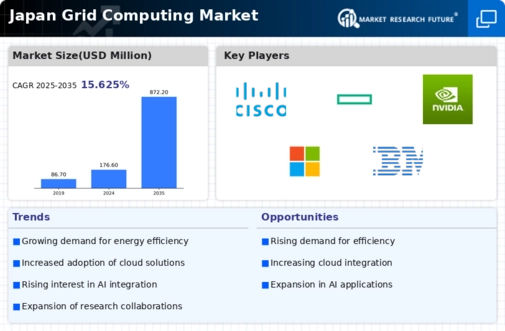Government Initiatives and Funding
Government initiatives in Japan are playing a crucial role in propelling the grid computing market forward. The Japanese government has recognized the importance of advanced computing technologies in fostering innovation and economic growth. As part of its strategic vision, the government has allocated substantial funding to support research and development in grid computing technologies. For instance, initiatives aimed at enhancing national research capabilities and promoting collaboration among academic institutions and industry players are expected to drive investments in grid computing infrastructure. This support is likely to create a conducive environment for the grid computing market, facilitating the development of cutting-edge solutions that can address complex computational challenges. Furthermore, government-backed projects may lead to increased adoption of grid computing systems across various sectors, thereby expanding the market's reach and potential.
Advancements in Network Infrastructure
Advancements in network infrastructure are significantly impacting the grid computing market in Japan. The deployment of high-speed internet and improved connectivity solutions is facilitating the seamless integration of grid computing systems across various sectors. Enhanced network capabilities allow for faster data transfer and communication between distributed nodes, which is essential for the efficient functioning of grid computing architectures. As organizations seek to optimize their operations and improve collaboration, the demand for reliable and high-performance network infrastructure is likely to grow. This trend is expected to drive investments in grid computing technologies, as businesses recognize the importance of robust network solutions in maximizing the benefits of grid computing. The grid computing market stands to gain from these advancements, as they enable organizations to harness the full potential of distributed computing resources.
Increased Focus on Collaborative Research
The grid computing market in Japan is benefiting from an increased focus on collaborative research initiatives. Academic institutions, research organizations, and private enterprises are increasingly recognizing the value of collaboration in addressing complex scientific and technological challenges. Grid computing provides a platform for these entities to share resources, data, and computational power, thereby enhancing research capabilities. Collaborative projects often require significant computational resources, which grid computing can efficiently provide. Recent collaborations in fields such as climate modeling, genomics, and artificial intelligence are indicative of this trend. As more organizations engage in collaborative research efforts, the grid computing market is likely to see a rise in demand for scalable and flexible grid solutions that can accommodate diverse research needs.
Growing Need for Data Management Solutions
The grid computing market in Japan is witnessing a growing need for effective data management solutions. As organizations generate vast amounts of data, the ability to efficiently store, process, and analyze this data becomes increasingly critical. Grid computing offers a viable solution by enabling distributed data processing and storage across multiple nodes, thereby enhancing data accessibility and reliability. Industries such as finance, healthcare, and telecommunications are particularly focused on leveraging grid computing technologies to manage their data more effectively. Recent reports indicate that the data management market in Japan is expected to reach approximately $5 billion by 2026, with grid computing playing a pivotal role in this growth. Consequently, the grid computing market is likely to see increased investments and innovations aimed at developing robust data management frameworks that can support the evolving needs of businesses.
Rising Demand for High-Performance Computing
The grid computing market in Japan is experiencing a notable surge in demand for high-performance computing (HPC) solutions. This demand is primarily driven by sectors such as scientific research, financial services, and healthcare, which require extensive computational power for data analysis and simulations. As organizations increasingly rely on data-driven decision-making, the need for efficient grid computing systems becomes paramount. According to recent estimates, the HPC market in Japan is projected to grow at a CAGR of approximately 8% over the next five years. This growth is likely to bolster the grid computing market, as HPC systems often leverage grid architectures to optimize resource utilization and enhance processing capabilities. Consequently, the grid computing market is poised to benefit from this rising demand, as it aligns with the broader trend of digital transformation across various sectors.
















Leave a Comment